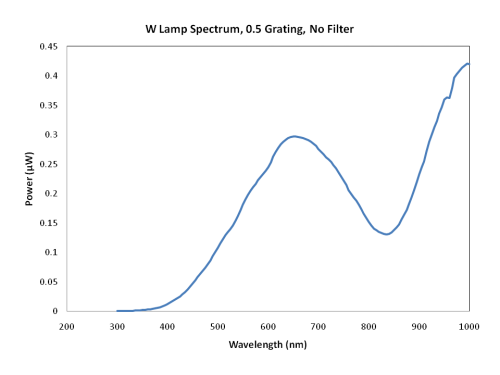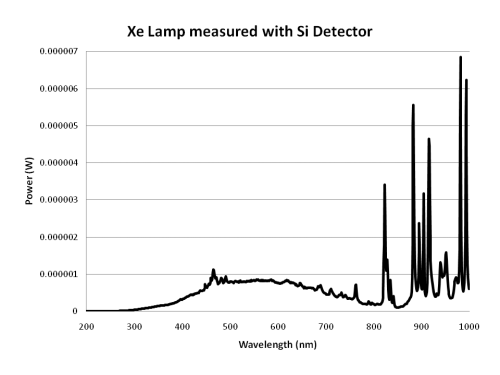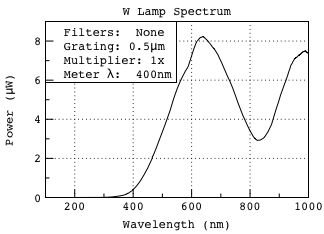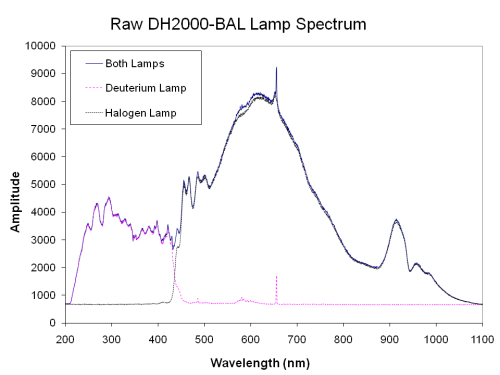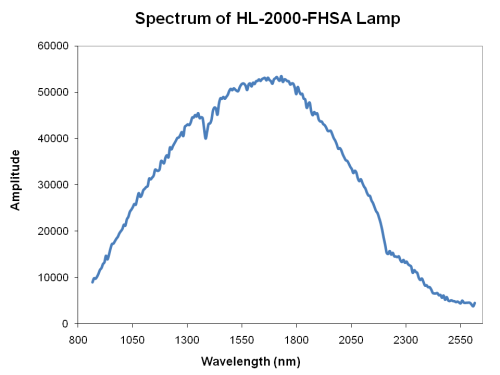Table of Contents
Optical Spectrometers
Located in David McIntyre's lab Weniger 118.
Scanning Monochromator (Grating Spectrometer or GS)
The Scanning Monochromator can make transmission, specular reflection, and diffuse reflection measurements on thin film, single crystal, and powder samples. Here is the grating spectrometer manual, written in 2002, parts of which may be obsolete, but the basic structure is OK.
Sources
There are two broadband sources for the Scanning Monochromator. The W-halogen lamp is used in the visible and NIR (note spectrum depends on filters and grating used):
and the Xe lamp in the UV-and visible.
Detectors
There are two detectors for the Scanning Monochromator. The Silicon detector is 13 mm^2 and works in the UV-Vis range 350-1100 nm (down to ~1.1 eV).
The InGaAs detector is used for NIR measurements and is 3.1 mm^2 and thus it's is much more difficult, compared to the Si detector, to capture all the light. This detector can work in the range of 800-1800 nm.
Gratings
There are five sets of gratings for the monochromators - 0.25 µm, 0.5 µm, 1.0 µm, 2.0 µm, and 4.0 µm. The number indicates the wavelength at which the gratings perform the best. Typically, for UV-Vis measurements, you want to use the 0.5µm gratings, because the lamp is fairly weak at this wavelength, yet very intense at 1.0 µm. Thus, you're unlikely to get a usable signal at 500 nm with the 1.0 µm gratings, but you will still get a strong a signal at 1 µm when using the 0.5 µm gratings.
A word of caution about the gratings: Reported problem, “I found that the monochrometer seems to be having trouble. I tried to reset it to 518 nm and found that thanks to what seems to be a belt problem, it is stuck at 926 nm”, David Mc responded on (9/12/21), “I (kind of) fixed the spectrometer. I know what the problem was, but I do not know what caused it. BUT, YOU should figure out what caused the problem, as it has damaged the instrument already and if it happens again it may further damage the instrument. The indicators on the 2 spectrometers read the wavelength in the range 0-999. But what they are really doing is indicating the angle of the grating, which is turned with the sets of gears and pulleys. The indicator that was at 926 nm had arrived at that point not by going from 518 nm up to 926 nm, but rather by going from 518 nm, down to 0 and thorough 0 (to the negative side) and stopping at 926. Thus the grating was at an angle where no light goes through the spectrometer. The spectrometer is not designed to go past 0, so the gears and belts locked up. By removing some belts and applying gentle but firm force, I was able to independently get the 2 spectrometers back into the “positive” region. With the coupling belt removed, I set one spectrometer to 518 and then adjusted the other by monitoring the spectrometer output. The output was maximized with the second spectrometer (closer to the lamp) set to 545 nm. This indicates that the gears and belts slipped quite a bit. Unfortunately, now we do not know which dial, if either, is correct. The system needs to be recalibrated. Moreover, the gears appear to slip during a manual scan and this may cause problems for a computer controlled scan.”
Sampling Accessories
The Scanning Monochromator has an Oriel 70491 integrating sphere to make diffuse reflection measurements.
Ocean Optics Spectrometer (OO; also "Fiber Optic Spectrometer")
The Ocean Optics Spectrometer can make transmission, specular reflection, and diffuse reflection measurements on thin film, single crystal, and powder samples. Diffuse reflection measurements can only be made on strongly diffusely reflecting materials.
Detectors
The Ocean Optics spectrometer has two detectors: Ocean Optics HR 4000 and Ocean Optics NIR256-2.5.
The Ocean Optics HR 4000 spectrometer is used to take ultraviolet-visible spectra. The HR 4000 has a 3648-element CCD-array detector with an optical resolution of 0.27 nm. The ultraviolet-visible measurements span a wavelength range from 200 nm to 1150 nm.
Ocean Optics NIR256-2.5 spectrometer is used to take the visible-near infer red spectra. The NIR256-2.5 has an InGaAs detector array with an optical resolution of 6.85 nm. The visible-near infer red measurements span a wavelength range of 850 nm to 2600 nm.
Light Sources
An Ocean Optics Mikropack DH-2000-BAL Deuterium Tungsten Halogen Light Source is used for the ultraviolet-visible measurements and an Ocean Optics Mikropack HL-2000 Tungsten Halogen Light Source is used for the visible-near infer red measurements. The spot size and incidence angle for both instruments are approximately 1.5 mm and 0 º.
Software & Data Analysis
- David McIntyre wrote a basic introduction to thin-film R and T analysis, explaining the T/(1-R) approach.
- Levi Kilcher wrote an Excel sheet called index calc (2006 version is here) to analyze R & T data from the grating spectrometer, to get index, band gaps etc. Here is a help file for the index calc spreadsheet. See also Reports page for presentation, and Levi Kilcher's thesis on thesis page.
- The Index_Calc2006.xls spreadsheet was fixed by James Haggerty (01/31/15). The Macro buttons should now be functional
- To use this and all the other spreadsheets given below you must enable the Solver add-in in the Excel Options Menu
- Under the Excel main menu open “Excel Options”, select the “add-ins” menu, “Solve Add-in” and select “Go”
- SCOUT software was worked on by Aaron Kratzer in 2013. Ryan Lance produced templates and instructions in 2017. See Ryan's and Aaron's theses on thesis page, and Ryan's SCOUT intro manual here SCOUT instructions and tips
- Update from James Haggerty (05/03/17)
- Here is an optical data processing .zip file which contains all the files needed to process both thin film and powder optical data collected on our spectrometers. Included are the following spreadsheets
- index_calc2015-V009.xlsm: the latest version of the thin film data processing sheet originally written by Levi Kilcher
- OO_Make_Int_Step_UV-IR-V01.xlsx: Used to convert both UV-Vis and IR data from the fiber optic spectrometer to integer steps in wavelength.
- Optical_Diff_Gap_Calc - V04.xlsm: Alternative band gap calculation that does not use the Tauc method. This method uses differentiation of the absorption model as a way to determine the band gap instead of the Tauc method. This spreadsheet can easily be modified to calculate band gaps for either absolute or relative absorption.
- Optical_Plots_Comparisons - V01.xlsx: Used to incorporate multiple data sets into one plot for trend identification
- Optical_Plots_MultiRange-V07.xlsm: Can be used to make a full spectrum data set from T and R data collected on two different spectrometers or two different regions collected by the same spectrometer. The plots used setup the data for the calculations of the Swanepole method for calculating absorption.
- Optical_Plots_SingleRange-V06.xlsm: Can be used to make plots of T and R from data collected on a single spectrometer. The plots used setup the data for the calculations of the Swanepole method for calculating absorption.
- Optical_Plots_MultiRange_Diffuse-V02.xlsm and Optical_Plots_SingleRange_Diffuse-V02.xlsm: These two are similar to the other optical plots spreadsheets of similar names and perform similar functions, but they are designed with diffuse reflection measurements in mind. The relative absorption calculated in these two sheets comes from the Kubelka-Monk theory for diffuse reflections.
- Optical_Tauc_Gap_Calc-V04.xlsm: This spreadsheet uses the traditional Tauc linearization of the absorption to determine the band gap values. This spreadsheet allows for both allowed and forbidden transitions to be calculated.
- Lastly and most importantly are the two PowerPoint files
- 17-0215_Optical_data_processing-Calculations_V01.pptx: Step-by-step guide to thin film optical properties calculation as well as band gap determination. This presentation applies to the following spreadsheets:
- index_calc2015-V009.xlsm, Optical_Diff_Gap_Calc - V04.xlsm, and Optical_Tauc_Gap_Calc-V04.xlsm
- 17-0328_Optical_data_processing-Optical_Plots_V02.pptx: Step-by-step guide to the optical plots spreadsheets. This presentation applies to the following spreadsheets:
- Optical_Plots_MultiRange-V07.xlsm, Optical_Plots_SingleRange-V06.xlsm, Optical_Plots_MultiRange_Diffuse-V02.xlsm, Optical_Plots_SingleRange_Diffuse-V02.xlsm, and OO_Make_Int_Step_UV-IR-V01.xlsx
Filmetrix Spectrometer (Not used much in 2020)
Documentation
There is a manual for the OO spectrometer located permanently in Wngr 118. Never remove it from that room. The manual is based on some of the following documentation:
- OO Fiber Optic Spectrometer Manual written by Josh Russell; last updated 2009.
- Ocean Optics Walkthrough - Emmeline Altschul, 2011
Optical data
| Date | Author | Title | Notes | |
|---|---|---|---|---|
| - | - | Optical constants from Sopra labs | Optical constants of many different materials. Widely quoted site. | |
| Journal of Physical and Chemical Reference Data 9, 561 (1980) | H. H. Li | Refractive Index of Silicon and Germanium and Its Wavelength and Temperature Derivatives | Exhaustive compilation of refractive index of Si, Ge, temp dep etc. Available at NIST reprint site. | |
| Journal of Physical and Chemical Reference Data 31, 931 (2002) | R.D. Shannon et al. | Refractive Index and Dispersion of Fluorides and Oxides | Exhaustive compilation of refractive index of fits to refractive indices of common fluoride and oxides using Sellmeier formalism. | |
| Journal of Physical and Chemical Reference Data 13, 103 (1984) | H. H. Li | Refractive Index of ZnS, ZnSe, and ZnTe and its wavelength and temperature derivatives | Exhaustive compilation of refractive index of ZnCh temp dep etc. Available at NIST reprint site. | |
| Melles Griot Technical Manual, Materials Properties | Melles Griot | Materials Properties | Good compilation of refractive index, transmission of different kinds of glasses - BK7, suprasil, CaF, crystal quartz, etc. Also silicon and germanium. | |
| Melles Griot Technical Manual, Optical Coatings | Melles Griot | Optical Coatings | Good discussion of coatings and materials, reflection, angles of incidence, phase changes, fringes etc. |
